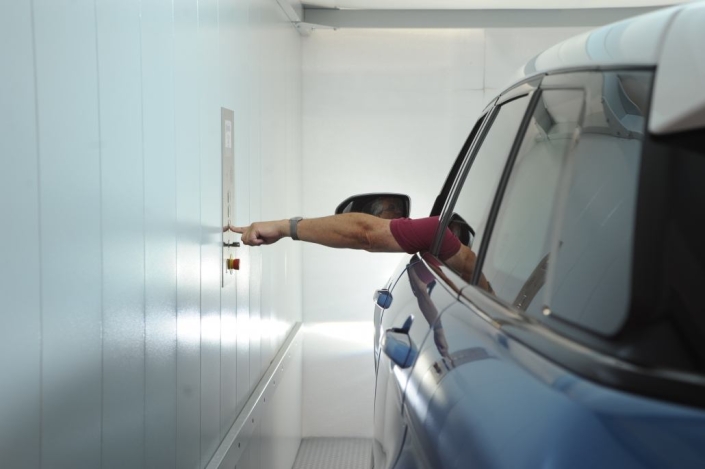Everything you need to know about vehicle elevators
Vehicle elevators are becoming increasingly essential in urban planning and modern building design, as space restrictions continue to grow. While ramps are traditionally the most common way to access underground parking, they often require extensive space and complex maneuvers. Vehicle elevators, on the other hand, offer a compact, efficient, and comfortable alternative for transporting cars and their occupants between different floors.
In this guide, we’ll cover everything you need to know about vehicle elevators, from their features and dimensions to their numerous benefits and typical uses.
What exactly is a vehicle elevator, and how does it work?
A vehicle elevator, also known as a car lift or automobile elevator, is specifically designed to move vehicles and their passengers vertically between floors in buildings or parking structures. Unlike freight elevators, which typically only transport goods and restrict passenger access, vehicle elevators are constructed to accommodate vehicles and allow passengers to remain safely inside during transit.
These elevators operate similarly to traditional passenger lifts, featuring a robust mechanical and hydraulic system that ensures a smooth and secure movement. They are widely used in residential buildings, commercial facilities, private garages, hotels, and public parking structures.
What are the standard dimensions of a vehicle elevator?
Vehicle elevators can be fully customized to suit the available space and specific requirements of each building. Nevertheless, there are certain common dimensions typically recommended:
-
Standard residential vehicle elevator dimensions usually start at approximately 2.6 meters wide and 5.2 meters deep. This size is sufficient for most standard cars, providing enough space for doors to open comfortably and passengers to enter or exit easily.
-
Commercial and industrial vehicle elevators often require larger dimensions due to the larger size of trucks, vans, or SUVs. These elevators can be customized to significantly larger dimensions to accommodate specific vehicle types and heavy-duty requirements.
It’s important to note that choosing the right dimensions will greatly depend on the types of vehicles expected to use the elevator, as well as the physical constraints of your building or parking area.
The major benefits of installing a vehicle elevator
Installing a vehicle elevator provides numerous advantages over traditional ramps or ground-level parking. Here are the key benefits in detail:

Space-saving solution for urban environments
Ramps occupy significant horizontal space due to their length and incline requirements. Conversely, vehicle elevators utilize vertical space, significantly reducing the surface area needed. This space-saving aspect makes them ideal for densely populated urban areas where land is limited and expensive.
Think of it like a regular staircase versus a passenger elevator—while stairs consume more floor area, elevators require only a shaft. Vehicle elevators apply the same principle, maximizing usable space.
Greater convenience and ease of use
Driving on steep, narrow ramps can be challenging, particularly for less experienced drivers. Vehicle elevators eliminate complex maneuvers, as users simply drive onto the platform and wait comfortably during transit. This ease of use enhances convenience and reduces stress, making parking effortless and user-friendly for everyone.
Improved safety and reliability
Today’s vehicle elevators incorporate advanced safety systems, including sensors, emergency braking mechanisms, automatic doors, and backup power systems. These features ensure that vehicles and passengers are safely transported between floors, significantly reducing the risk of accidents and mechanical failures.
With robust engineering and rigorous safety standards, vehicle elevators represent one of the safest options available for vehicle transit in multi-story parking.
Increased parking capacity and property value
By using vehicle elevators, building managers and developers can significantly increase the parking capacity of a building without the need to extend horizontally. This not only improves parking availability for users but can also add substantial value to residential or commercial properties. Additional underground or upper-level parking floors can be easily integrated using elevators.
Which businesses can benefit most from vehicle elevators?
Many businesses and property types can greatly benefit from the installation of vehicle elevators. These include:
-
Shopping centers and commercial buildings: They streamline traffic flow, reducing wait times and enhancing customer convenience.
-
Residential complexes and hotels: Providing residents and guests convenient access to parking, significantly improving overall satisfaction.
-
Urban public parking facilities: Increasing available parking spaces while efficiently utilizing limited urban space.
-
Private garages and luxury residences: Offering a practical, sophisticated solution that aligns with modern design aesthetics and space efficiency.
Whether you manage a residential building, shopping center, hotel, or any facility requiring efficient parking solutions, a vehicle elevator can significantly enhance your property’s functionality, safety, and overall appeal.
Need more information or planning a vehicle elevator project?
At Elevadores Vilber, our dedicated and highly skilled team specializes in designing, installing, and maintaining custom vehicle elevators tailored precisely to your needs. With extensive experience in accessibility solutions and vertical transportation systems, we ensure your project meets the highest standards of quality and safety.
Contact Elevadores Vilber today to discuss your project requirements, dimensions, and budget considerations. We’re here to assist you every step of the way, providing a comprehensive solution to meet your exact specifications.





